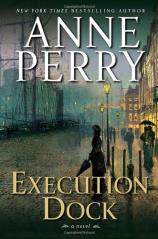Execution Dock
Review
Execution Dock
Anne Perry brings back one of her serial investigators,
Commander William Monk, in his 16th adventure. We last read about
Monk three years ago in DARK ASSASSIN. This time out, Monk has
taken over as Commander of the River Police with the responsibility
of patrolling the Thames River. He inherited this position as a
result of the untimely death of his predecessor and friend,
Commander Durban.
The first thing Monk must attend to is the case that Durban was
investigating when he died --- the murder of a 13-year-old boy
known only as Fig, allegedly killed at the hands of the dreaded
kingpin of the docks, Jericho Phillips. Phillips is known to run a
floating brothel along the Thames River whereby young boys are
abducted and forced to endure unspeakable acts as sex slaves, often
times ending in their ultimate disappearance and death. Monk vows
to bring Phillips to justice and see him hang in an effort to clean
up the area and also avenge the late Commander Durban.
The area known as Execution Dock refers to the section of docks
located on the Thames in the Wapping area of London, England. It
was used for more than 400 years (as late as 1830) to hang pirates,
smugglers and mutineers who had been sentenced to death by the
Admiralty courts. It is ironic that Phillips, a pirate in his own
right, is sought for hanging for alleged sins committed in this
very location. However, he is a wily and nefarious character who
boasts several important and well-to-do members of London society
as his clients, so sentencing him to hanging may not be as easy as
it would seem.
Fairly early in the novel, Phillips is apprehended and put on
trial for the murder of young Fig. It appears to be an open and
shut case that no reasonable jury would ever fail to convict on.
However, Monk will soon find out that it is not as easy as he
thought and quickly realizes why his late predecessor died in vain
trying to silence his “white whale.” EXECUTION DOCK is
unlike a typical William Monk mystery, as he turns out to be one of
many central characters in the story. This book belongs just as
much to his wife, Hester, a nurse and primary witness for the
prosecution. Hester is well-respected and known to have served
proudly under the famous nurse Florence Nightingale. With her
testimony and that of other character witnesses, there is no way
Phillips will not be convicted.
Standing in defense of Phillips is Oliver Rathbone, a friend and
sometime collaborator of Monk’s. This makes for an uneasy
situation as former colleagues are on opposite sides in the case.
Equally unsettling is the fact that at one time Hester had been in
a relationship with Rathbone prior to her marriage to William.
Rathbone does no more than any good defense attorney would be
expected to do as he fairly and justly represents his client.
However, the line of questioning soon takes a turn as Rathbone
begins to paint a picture of doubt around the proof of
Phillips’s alleged crime. At the same time, Rathbone portrays
former Commander Durban as being both obsessive and possibly in
league with Phillips. With Durban not alive to defend himself, the
defense rests having raised enough doubt that the jury comes back
with a startling verdict of not guilty.
With the rule of double jeopardy in effect, Monk realizes that
he will be unable to re-try Phillips for Fig’s murder. He
will have to find evidence of other killings or criminal acts to
tie Phillips to in order to present an air-tight case. This is not
made easy as the influential and powerful forces that paid for
Phillips’s initial defense do not want to see him convicted
ever and will go to any ends to accomplish this. Monk has the dual
challenge of seeking to clear the good name of his late
predecessor, who had his reputation unreasonably besmirched during
the Phillips trial.
As Monk and his team work tirelessly to hunt down proof by which
they can nail Phillips, Hester is conducting her own investigation
into Durban’s past to see if there was any merit to the
allegations that his relationship with Phillips was anything less
than it appeared to be. What Hester uncovers will show Durban in a
slightly different light than the persona he had presented during
his time as River Commander --- but is this enough to totally
disregard his case and pursuit of Phillips? Other characters are
recruited to assist in the investigations --- particularly a young
boy from the docks named Scuff and a slightly dim-witted assistant
to Hester, Claudine Burroughs. Additionally, Rathbone has been
having continued feelings of guilt for helping to acquit a
defendant he himself knew to be guilty. He conducts a similar
background check of the facts he obtained surrounding the identity
of the party that paid for the defense of Phillips --- and is
startled by what he uncovers.
Anne Perry, in her usual indomitable style, deftly weaves all of
the storylines and investigations together and paints a picture of
corruption that runs so high and deep that it may present
insurmountable odds against justice ever being realized in the case
of the evil Jericho Phillips. As always, her writing easily
transports you into Victorian London and takes you to the often
unglamorous areas of this volatile period. Any time spent with
William Monk, as well as his associates and family, is time well
spent. I very much look forward to his next mystery!
Reviewed by Ray Palen on January 21, 2011











